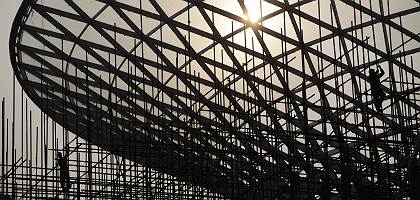|
|


ADVERTISEMENT
Buy Your own advertising
spaces!
.
Download Adobe Acrobat Reader to open [PDF] files.
Recent Visitors
Debunking the Shanghai myth
2009. 21 June
 Workers in China putting together a solar energy facility in Shanghai in preparation for the 2010 Expo.(photo by Reuters)
Workers in China putting together a solar energy facility in Shanghai in preparation for the 2010 Expo.(photo by Reuters)
(themalaysianinsider.com) Paris of the East, Queen of the Orient, Whore of Asia, New York on Steroids. Whatever the label over the decades, Shanghai, flaunting a bosom heavy with myth and Maglev-speed modernisation, has long lured visitors to her famed Bund waterfront — only to bust the fantasy of her admirers.
For the lady scorns being girdled in an “Orient-meets-Occident” construct.
Next year, when some 70 million visitors pour into Shanghai for the World Expo 2010, she will deal a “one-two punch to knock out old conceptions of China”.
Thus says noted historian Jeffrey Wasserstrom, who debunks the “East meets West” image of Shanghai.
This label fails to capture the multitude of Western voices and Chinese viewpoints facing off and converging there, argues the author of Global Shanghai 1850-2010: A History In Fragments, published this year.
“Global” Shanghai today is as much a hotpot for East-meets-East as West-meets-West.
Yet, Professor Wasserstrom, who teaches history at the University of California, Irvine, himself was once victim to what he calls the “fairy tale versions of Shanghai”.
He confesses to having felt “let down” during his first two visits to Shanghai in the 1980s, when he was confronted with “the contrast between the drab city I found...and the exciting one I had conjured up in my imagination”.
The fairy tale illusion is woven out of the countless representations and misrepresentations of various media — authors, film-makers, storytellers, reporters and wanderlust travellers.
But with each subsequent visit over the years, he finds Shanghai transforming itself more and more into the object of his imagination — and beyond.
The city — which plays host to the most massive showcase of some 230 countries’ freshest, most imaginative products and offerings next year — is defining itself on its own terms, he points out.
It is undergoing a process of “reglobalisation” — probing its historical roots as a treaty port to enrich its future as an international port of call for fusion ideas both Eastern and Western.
Indeed, the “New Shanghai” of Wasserstrom’s historical account is embedded deeply in its past.
Depending on who you listen to, Shanghai was born in either 1843 or 1291.
The account of the Shanghailanders — as foreigners during the treaty-port era were known — was that Westerners colonised the sleepy fishing village on Huangpu river on Nov 17, 1843 when the city was opened to foreign trade and settlement. They created “something from nothing in an almost magical way”.
But the Chinese Communist Party would have none of this: 1291 was the year Shanghai’s name first appeared in official documents, it says.
Rather than waddling into an East-West debate, however, Wasserstrom chooses to dwell on another starting point to kick off his narrative: 1850, the year that the English-language North China Herald — Shanghai’s first newspaper — was launched.
Shanghai was also the home of the radical Gang of Four who helped to stoke Mao Zedong’s revolutionary frenzy.
The professor’s narrative is divided into seven-year periods, each a quarter of a century apart from 1850 to 2000, marking such events as the Boxer rebellion in 1900 and the Kuomintang”s battle in the city in 1941 which led to 250,000 deaths in mere months.
But Wasserstrom also uses seemingly small details like the personal stories of so many local residents who witnessed Shanghai’s changes from the inside out.
These personal accounts offer a solid footing for daily life in a city more often depicted by a tiny Shanghailander community or dispassionate historians.
Wasserstrom also loads up on concrete details of how Shanghai has been speeding ahead since the late patriarch Deng Xiaoping made it a Special Economic Zone in 1990, giving it special privileges to stimulate economic growth.
From its 400km/h high-speed Maglev train and its Starbucks caffeinated culture to the new state-of-the-art Formula One circuit hosting China’s first Grand Prix, Shanghai — which he describes as “a city in a hurry” — is racing towards its biggest fantasy: hosting the Expo — the equivalent of a global “commerce Olympics”.
It was a dream it made for itself, not foisted on by Western fantasisers.
For Shanghai had birthed the Qing Dynasty’s China pavilions which participated in the world expos of the 1870s.
But she wanted more — to cradle such an international showcase herself.
Some 100 years ago, influential scholars Liang Qichao and Lu Shi’e were already predicting that Shanghai would one day host the event, while Shanghai-based novelist Wu Jianren put a prescient twist to 18th century Chinese classic Dream Of The Red Chamber, in which the hero Jia Baoyu roams a World Expo in the Pudong area.
The Expo, as Fudan University professor Li Tiangan said, is “nothing less than a catalyst for humanity’s integration”, which will forge a “spiritual legacy” for Shanghai.
Or, in Wasserstrom’s words, the 2010 moment of this “futuristic city” has arrived.
Watch out, world. — The Straits Times


